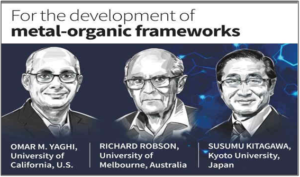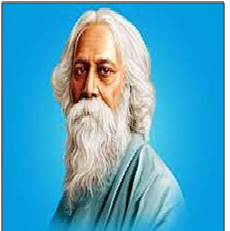Archives
(PRELIMS Focus)
Category: Science and Technology
Context:
- An Australian, a Japanese and a Jordanian-American scientists were announced winners of the Nobel Prize in Chemistry for discovering and creating a class of materials, called metal-organic frameworks (MOF).
About Nobel Prize in Chemistry 2025:

- Awardees: The Nobel Prize in Chemistry 2025 has been awarded to Scientists Susumu Kitagawa, Richard Robson, and Omar Yaghi for the development of metal-organic frameworks (MOFs).
- Significance: Their pioneering work on MOFs porous materials with vast surface areas has revolutionized applications in gas storage, catalysis, and environmental sustainability. The discovery represents a transformative advancement in chemical sciences, with potential benefits for medicine, clean energy, and climate solutions.
- Applications:
- Following the laureates’ groundbreaking discoveries, chemists have since built tens of thousands of different MOFs.
- Some of these may contribute to solving some of humankind’s greatest challenges, with applications that include separating PFAS (a family of chemicals that are believed to be toxic) from water, breaking down traces of pharmaceuticals in the environment, capturing carbon dioxide or harvesting water from desert air
- About the experiment:
- It all started in 1989, when Richard Robson tested utilising the inherent properties of atoms in a new way. He combined positively charged copper ions with a four-armed molecule; this had a chemical group that was attracted to copper ions at the end of each arm.
- When they were combined, they bonded to form a well-ordered, spacious crystal. It was like a diamond filled with innumerable cavities. Robson immediately recognised the potential of his molecular construction, but it was unstable and collapsed easily.
- However, Susumu Kitagawa and Omar Yaghi provided this building method with a firm foundation; between 1992 and 2003 they made, separately, a series of revolutionary discoveries.
- Kitagawa showed that gases can flow in and out of the constructions and predicted that MOFs could be made flexible. Yaghi created a very stable MOF and showed that it can be modified using rational design, giving it new and desirable properties.
Source:
Category: History and Culture
Context:
- The Odisha government has announced plans to restore ‘Pather Puri’, the residence of Nobel laureate Rabindranath Tagore in Puri, and transform it into a museum.
About Rabindranath Tagore:

- Background: He was the youngest of 13 children born to Debendranath Tagore, a leading figure in the Brahmo Samaj, and Sarada Devi. Tagore received early education at home, with his family emphasizing literary and cultural learning.
- Schooling and higher education: He attended several schools, including a stint at the University College London, though he did not complete formal schooling.
- Multi-faceted personality: Rabindranath Tagore was a Bengali poet, novelist, and painter, who was highly influential in introducing Indian culture to the west. He was an exceptional literary figure and a renowned polymath who singlehandedly reshaped the region’s literature and music.
- Sobriquets: He was also referred to as ‘Gurudev’, ‘Kabiguru’, and ‘Biswakabi’.
- Association with Mahatma Gandhi: He was a good friend of Mahatma Gandhi and is said to have given him the title of Mahatma.
- Votary of national integration: He had always stressed that unity in diversity is the only possible way for India’s national integration.
- World Parliament for Religions: He had spoken at the World Parliament for Religions in the years 1929 and 1937.
- Contribution to education system: Besides all his literary achievements he was also a philosopher and educationist who in 1921 established the Vishwa-Bharati University, a university that challenged conventional education.
- Contributions as a poet:
- He is said to have composed over 2000 songs and his songs and music are called ‘Rabindra Sangeet’ with its own distinct lyrical and fluid style.
- He is responsible for modernising Bengali prose and poetry. His notable works include Gitanjali, Ghare-Baire, Gora, Manasi, Balaka, Sonar Tori, He is also remembered for his song ‘Ekla Chalo Re’.
- He published his first poems aged 16 under the pen-name ‘Bhanusimha’.
- He not only gave the national anthems for two countries, India and Bangladesh, but also inspired a Ceylonese student of his, to pen and compose the national anthem of Sri Lanka.
- Awards:
- In 1913 he was awarded the Nobel Prize in Literature for his work on Gitanjali.
- He was the first non-European to receive the Nobel Prize.
- In 1915 he was awarded knighthood by the British King George V. In 1919, following the Jallianwalla Bagh massacre, he renounced his Knighthood.
Source:
Category: Government Schemes
Context:
- The Union government is looking to showcase the PM-KUSUM (Pradhan Mantri Kisan Urja Suraksha evam Utthan Mahabhiyan) programme to several African countries and island nations, Union Minister for Renewable Energy (MNRE) said.
About PM-KUSUM Scheme:

- Launch: The PM-KUSUM was launched by the MNRE in 2019, in order to endow installation of off-grid solar pumps in rural areas and reduce dependence on grid, in grid-connected areas.
- Objective: It aims to enable farmers to set up solar power generation capacity on their arid lands and to sell it to the grid. It also seeks to increase the income of farmers by allowing them to sell surplus solar power to the grid.
- Components of the scheme:
- 10,000 MW of decentralized ground-mounted grid-connected renewable power plants.
- Installation of 20 lakh solar-powered agriculture pumps.
- Converting 15 lakh agriculture pumps, already connected to the grid, into solar.
- Significance:
- It incentivises the farmers to sell surplus solar energy to the states, which in turn will augment their income.
- If farmers are able to sell surplus power, they will be incentivised to save power and, in turn, it will mean the reasonable and efficient use of groundwater.
- The scheme is expected to create job opportunities in the installation, maintenance, and operation of solar power projects.
- Challenges:
- The cost of setting up solar power projects can be high, and some farmers may not have access to the necessary financing.
- Due to power subsidies, the recurring cost of electricity is so low that farmers keep on pumping water and the water table is going down.
- Integrating decentralized solar power projects into the grid may pose technical challenges and stability issues, which need to be addressed.
Source:
Category: Defence and Security
Context:
- The Indian Air Force (IAF) celebrated its 93rd anniversary on 8th October with a ceremonial parade at the Air Force Station, Hindon.
About Indian Air Force (IAF):

- Establishment: The Indian Air Force was officially established on 8 October 1932 as an auxiliary unit of the Royal Air Force. The first squadron became operational on 1 April 1933 with six officers and four Westland Wapiti biplanes.
- Full-fledged aerial force: After independence in 1947, the IAF became a crucial arm of India’s defence, evolving from a small air wing into a modern and powerful aerial force.
- Motto: The motto of the Indian Air Force is “Nabhah Spriśam Deeptam” which translates to “Touch the Sky with Glory.” It is derived from the Bhagavad Gita (Chapter 11, Verse 24) and reflects the IAF’s spirit of valor, excellence, and limitless ambition.
- Emblem: The emblem of the Indian Air Force features the Ashoka Chakra at its center, symbolizing righteousness and unity, with wings on either side representing speed, power, and freedom.
- Structure: The Indian Air Force (IAF) is organized into seven commands: Five operational commands (Western, Eastern, Central, Southern, South Western) and two functional commands (Training and Maintenance) to ensure effective command and control of air assets and personnel.
- Ranking: The Indian Air Force (IAF) maintains a well-defined rank structure that ensures discipline, leadership, and a clear chain of command. It is divided into three main categories:
- Commissioned Officers (Leadership and Command roles)
- Junior Commissioned Officers (JCOs) / Warrant Ranks
- Non-Commissioned Officers (NCOs) / Airmen.
- Key Historical Milestones:
- 1947 – IAF participates in Jammu & Kashmir operations post-independence.
- 1965 & 1971 – Major contributions during Indo-Pak wars; decisive in the 1971 victory.
- 1999 – Role in Kargil War, showcasing precision air strikes at high altitudes.
- 2025 – 93rd anniversary marking technological modernization and global outreach.
Source:
Category: Polity and Governance
Context:
- A Supreme Court lawyer has written to Attorney-General seeking consent to initiate criminal contempt proceedings against advocate who allegedly flung papers at Chief Justice of India (CJI) B.R. Gavai during court proceedings.
About Contempt of Court:
- Objective: Contempt of court seeks to protect judicial institutions from motivated attacks and unwarranted criticism, and as a legal mechanism to punish those who lower its authority.
- Legal backing:
- When the Constitution was adopted, contempt of court was made one of the restrictions on freedom of speech and expression under Article 19 (2) of the Constitution of India.
- Separately, Article 129 of the Constitution conferred on the Supreme Court the power to punish contempt of itself. Article 215 conferred a corresponding power on the High Courts.
- The Contempt of Courts Act, 1971, gives statutory backing to the idea.
- Punishment:
- A person found guilty of contempt of court can be sentenced to simple imprisonment for up to six months or fined up to Rs. 2,000 or both.
- In the case of criminal contempt, the Supreme Court or the High Court may take action on its motion or a motion made by the Advocate-General or any other person, with the consent in writing of the Advocate-General.
Types of Contempt of Court:
- Civil Contempt: Section 2(b) of Contempt of Court Act 1971 defines civil contempt as wilful disobedience to any judgment, decree, direction, order, writ or other process of a court or wilful breach of an undertaking given to a court.
- Criminal Contempt: Section 2(c) of the Contempt of Court Act 1971 defines criminal contempt as the publication (whether by words, spoken or written, or by signs, or by visible representations, or otherwise) of any matter or the doing of any other act whatsoever which:
- scandalises or tends to scandalise, or lowers or tends to lower the authority of, any court; or
- prejudices, or interferes or tends to interfere with the due course of any judicial proceeding; or
- interferes or tends to interfere with, or obstructs or tends to obstruct, the administration of justice in any other manner.
Source:
(MAINS Focus)
(GS Paper 2: Polity and Governance – Mechanisms, Laws, Institutions and Bodies Constituted for the Protection and Betterment of Citizens)
Context (Introduction)
Preventive detention, a colonial-era mechanism meant to stop crimes before they occur, has become a troubling feature of India’s democracy. Despite repeated Supreme Court warnings, its broad use threatens liberty, equality, and due process — the pillars of constitutional justice.
Constitutional and Judicial Concerns
- Judicial Safeguards on Liberty: In Dhanya M. vs State of Kerala (2025), the Supreme Court set aside a preventive detention order under the Kerala Anti-Social Activities (Prevention) Act (KAAPA), stressing that such extraordinary power must be used sparingly and only with constitutional safeguards.
- Public Order vs Law and Order: The Court clarified that preventive detention cannot be used for ordinary “law and order” issues but only when “public order” is at stake. Yet, state laws like KAAPA have blurred this line by giving sweeping definitions to “goonda” and “rowdy.”
- Colonial Legacy and Constitutional Embedding: The roots of preventive detention lie in the Bengal Regulation of 1818, used by the British to maintain control. Despite its colonial nature, it was retained in independent India through Articles 22(3)–(7), creating a constitutional space where liberty can vanish without trace.
- Judicial Endorsement of Executive Power: In A.K. Gopalan vs State of Madras (1950), the Supreme Court upheld detention without trial, isolating Article 22 from Articles 14, 19, and 21. This judgment turned preventive detention into what Somnath Lahiri called a “Police-Constable Constitution.”
- Post-Maneka Gandhi Inconsistency: Although Maneka Gandhi vs Union of India (1978) declared that any law curtailing liberty must be “fair, just, and reasonable,” the Court in A.K. Roy vs Union of India (1982) held that preventive detention could not be tested on that standard—leaving Article 22 detached from the rest of the rights framework.
Criticisms and Drawbacks
- Erosion of Fundamental Rights: Article 22 has become a “Bermuda Triangle” in India’s Constitution where the rights to equality, liberty, and due process disappear, isolating detainees from constitutional protection.
- Executive Overreach: Preventive detention laws have become a convenient tool for governments to silence dissent, bypass bail orders, and target political opposition or protest movements.
- Weak Procedural Safeguards: Detentions based on the “subjective satisfaction” of officials allow arrests without concrete evidence, leaving little scope for judicial scrutiny.
- Colonial Continuity: What was an emergency tool under British rule is now embedded as a normal part of India’s democratic governance, contrary to the ideals of liberty and justice.
- Decline in Investigative Standards: As Granville Austin warned, reliance on detention without trial creates “atrophy in police investigatory and prosecutorial skills,” weakening faith in the rule of law.
Reforms and Recommendations
- Restrict Use to Serious Threats: Preventive detention should be confined to grave matters such as terrorism or transnational crime, not routine administrative issues.
- Integrate Article 21 Protections: The fairness and due process standards from Maneka Gandhi must be extended to preventive detention, ensuring liberty is not curtailed without strong justification.
- Strengthen Judicial Oversight: Courts should review detentions more frequently, and advisory boards must act independently to check misuse.
- Define Scope and Ensure Transparency: Terms like “public order” and “habitual offender” need clear, narrow definitions. Detention orders must include written, reviewable reasons.
- Reform Policing and Investigation: Improving police efficiency and prosecution systems will reduce dependence on detention laws and promote evidence-based justice.
Conclusion
Preventive detention represents one of the deepest contradictions in India’s constitutional democracy — a colonial relic existing within a liberal framework. The Supreme Court’s recent warning in Dhanya M. revives the call to re-examine the A.K. Gopalan and A.K. Roy doctrines. Unless preventive detention is limited to the most exceptional circumstances, India risks turning its “constitutional safeguard” into a permanent instrument of control, eroding the very liberty it seeks to protect.
Mains Question
- Preventive detention was meant as an exceptional safeguard but has become a routine administrative tool. Examine its constitutional basis with help of judicial pronouncements . (250 words, 15 marks)
(GS Paper 2: Governance – Welfare Schemes for Vulnerable Sections of the Population and Mechanisms, Laws, Institutions and Bodies Constituted for the Protection and Betterment of Citizens)
Context (Introduction) The recent tragedies at Telangana’s Sigachi Industries, Sivakasi’s Gokulesh Fireworks, and Chennai’s Ennore Thermal Plant highlight a grim reality — India’s workplace safety is deteriorating, reflecting the erosion of workers’ rights and weakening enforcement of labour laws.
Nature and Causes of Industrial Accidents
- Negligence and Profit-Driven Practices: Industrial accidents, such as the Sigachi factory explosion, occur not by chance but due to deliberate neglect. The chemical reactor was operated at twice the permitted temperature, alarms failed, and there was no safety supervision or emergency response.
- Failure of Preventive Measures: Outdated machinery, ignored maintenance, and untrained workers reflect poor enforcement of safety norms. At Ennore, a 10-metre-high coal-handling structure collapsed, likely due to faulty design and weak scaffolding, revealing chronic underinvestment in safety.
- ILO’s Global Warning: The International Labour Organization (ILO) notes that industrial accidents rarely occur randomly—they result from managements cutting costs, extending working hours, and pushing workers into unsafe conditions. India alone accounts for nearly one in four fatal workplace deaths globally.
- Unregistered and Informal Workers: Most victims belong to the informal or contractual workforce, whose employment is unrecorded. The absence of entry registers, safety audits, and accountability hides the true scale of casualties.
- Culture of Impunity: Governments often announce ex gratia payments from public funds instead of holding employers criminally liable, turning compensation into charity and shielding corporate negligence.
Criticisms and Drawbacks
- Weak Enforcement of Labour Laws: Inspection-based regulation has been replaced by self-certification, weakening oversight. Employers face little scrutiny, and penalties are either delayed or symbolic.
- Dilution of Protective Frameworks: The Occupational Safety, Health and Working Conditions (OSHWC) Code, 2020 seeks to replace the Factories Act, 1948, but reduces worker safety from a statutory right to an executive discretion, weakening accountability.
- Inadequate Compensation Mechanisms: The Workmen’s Compensation Act, 1923 and Employees’ State Insurance Act, 1948 exist, but compensation remains meagre and delayed, failing to cover lifetime income loss.
- Overwork and Unsafe Conditions: States have extended working hours post-pandemic, such as Karnataka in 2023, increasing daily limits and reducing rest periods—factors that directly compromise safety and health.
- Neglect of Informal Sector: With over 90% of India’s workforce in informal jobs, safety coverage is minimal. Unregistered employment means no legal recourse or compensation for the families of victims.
Reforms and Way Forward
- Restore Workplace Safety as a Fundamental Right: Safety and health should be recognised as non-negotiable rights, not matters of executive discretion.
- Reinstate Inspection as Enforcement: Surprise inspections and stricter penalties for violations should replace the current self-certification model that enables concealment of unsafe practices.
- Criminal Accountability of Employers: Laws must hold employers criminally liable for preventable deaths and injuries, ensuring deterrence through prosecution rather than mere financial penalties.
- Ensure Universal Coverage: Extend the scope of safety laws and compensation to all categories of workers, including contract and informal labourers.
- Strengthen Institutional Mechanisms: Empower labour departments, industrial safety directorates, and trade unions to monitor compliance and ensure independent audits of high-risk industries.
Conclusion
India’s industrial landscape reflects a growing gap between law and practice. As the ILO reminds us, accidents are not inevitable—they are the outcome of neglect and greed. To prevent another Sigachi or Ennore tragedy, workplace safety must be restored as a core labour right, employers must face criminal liability for violations, and the State must act as a guardian of dignity, not a bystander to disaster.
Mains Question
Q. The increasing frequency of industrial accidents in India highlights the weakening of workplace safety and labour rights. Discuss the causes behind this erosion and suggest reforms to strengthen occupational safety in the country. (250 words, 15 marks)
(GS Paper 2: International Relations – India and its Foreign Policy, Effect of Policies and Politics of Developed and Developing Countries on India’s Interests)
Context (Introduction)
Amid growing global uncertainty and shifting power equations among the US, Europe, Russia, and China, External Affairs Minister S. Jaishankar has reaffirmed India’s commitment to strategic autonomy—a pragmatic, adaptive approach aimed at accelerating India’s rise as an independent global pole.
Meaning and Evolution of Strategic Autonomy
- From Ideology to Pragmatism: Jaishankar defines strategic autonomy not as an abstract ideal but as a methodology — a flexible, context-based strategy allowing India to engage with all major powers while preserving decision-making independence.
- Historical Continuity: Even when India was much weaker post-Independence, it avoided alignment with any single bloc. Today, as a stronger nation, this freedom of choice remains intrinsic to India’s foreign policy identity.
- Linked to Adaptability and Resilience: Strategic autonomy, according to Jaishankar, is not automatic. It requires constant adaptation — “revising, refreshing, and recalculating” policies as global conditions change, without being tied to any one partner.
- Avoiding Misinterpretation as Indecision: The minister warns against equating autonomy with fence-sitting. Instead, it demands proactive engagement, resisting coercion into alliances while seizing opportunities that align with India’s long-term interests.
- Objective – Accelerating India’s Rise: Strategic autonomy is ultimately about using relations with all powers—be it the US, Russia, Europe, or the Global South—to advance India’s growth, security, and standing as a key global actor.
Criticisms and Challenges
- Re-hyphenation with Pakistan: Despite India’s economic and geopolitical lead, recent US references to mediating Indo-Pak disputes have revived comparisons. Jaishankar cautions against allowing domestic political rhetoric to re-link India’s image with Pakistan’s instability.
- Domestic Politicisation: The editorial notes that anti-Pakistan populism at home risks self-inflicted “hyphenation,” undermining India’s international confidence and credibility as a mature power.
- Pressure from Global Power Blocs: The deepening rivalries among the US, China, and Russia may test India’s ability to maintain balance without appearing ambivalent or opportunistic.
- Economic and Strategic Dependencies: India’s reliance on Western technology and Russian defence imports creates practical limits to autonomy unless diversification and indigenisation are strengthened.
- Perception of Neutrality: In times of global crisis—Ukraine war, Middle East conflict—India’s cautious diplomacy may be misread as indecision rather than independence, requiring clear articulation of strategic intent.
Reforms and Way Forward
- Institutionalise Policy Adaptability: Create agile policy frameworks within the MEA and NITI Aayog that enable quick recalibration of external partnerships based on evolving national interests.
- Deepen Multipolar Engagement: Enhance ties across regions—Europe, ASEAN, Africa, and Latin America—to prevent overdependence on any one axis of power.
- Strengthen Economic and Technological Self-Reliance: Initiatives like Atmanirbhar Bharat and Make in India should reinforce the material base of strategic autonomy.
- De-hyphenate Domestic Politics from Foreign Policy: Insulate diplomacy from populist narratives, focusing instead on India’s long-term image as a stable and responsible global power.
- Promote Values-Based Realism: Combine autonomy with credibility—project India as a nation that pursues its interests while contributing to a more just, multipolar, and cooperative world order.
Conclusion
As the global order fractures into competing blocs, India’s strategic autonomy is not a luxury but a necessity. It must remain dynamic, rooted in national capacity, and free from domestic political constraints. By balancing principle with pragmatism, India can truly emerge as an independent pole of stability and growth in an uncertain world.
Mains Question
- In an increasingly fragmented world order, strategic autonomy remains central to India’s foreign policy. Examine its evolution, contemporary relevance, and the challenges in sustaining it amid great power rivalries. (250 words, 15 marks)
